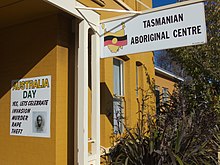Tasmanian Aboriginal Center
The Aborigines of Tasmania , called Tasmanians , call themselves Palawa . They founded the Tasmanian Aboriginal Center (TAC), run by Michael Mansell . Since the mid-1970s, the interests of the Tasmanians have been represented by this center, which also manages the protected areas established since 1999.
Palawa
The Tasmanians of today are all descendants of Tasmanians and Europeans and to a large extent of Fanny Cochrane Smith , who was married to a man of European descent. This group of people lives on Tasmania and some offshore islands in the Bass Strait. They consider themselves legitimate descendants of the Tasmanians, but their status is controversial.
The TAC only recognizes the Tasmanians of the Bass Strait Islands, descended from Mannalargenna , the tribal elder of the Plangermairiener (Ben Lomond), and his descendants Dolly Dalrymple and Fanny Cochrane Smith, as legitimate Tasmanians. With this definition by the Palawa, only the “well known family names” such as Maynard, Brown, Burgess, Mansell, Smith, Thomas, Everett, Gower and some other Tasmanians are descendants of the indigenous people of Tasmania.
Every January the Palawa community holds a festival at Oyster Cove to commemorate their land rights, which the British took from them when they occupied the land. Only in 1995 were parts of the country returned to the indigenous population.
Lia Pootah
Another group, the Lia Pootah, reject this stipulation and criticize the fact that the Palawa Aboriginal community is in the minority and they are in the majority and that this has resulted in great confusion among the Tasmanians. The Lia Pootah insinuate that the Palawa received a dictation over the majority of Tasmanians under the aegis of two Tasmanian governments; this is undemocratic and un-Australian.
differences
The Palawa argue against the criticism of the Lia Pootah that only the successors of Manalaganna and Fanny Cochran Smith have land rights and this right has already been recognized by the state. This is also evidenced by the fact that the Fanny Cochrane Smith government gave 121 hectares of land at the beginning of the 19th century and that the Palawa received additional land in 1995. The Palawa also note that the Tasmanian Government assumes that the Palawa are the original Tasmanians and only recognizes them. The Lia Pootah also criticize the fact that the Palawa name places according to their ideas of names and that they determine historical events and control land to which they have no blood rights. The argument put forward by the Lia Pootah that the Palawa are in the minority is refuted by figures from Mansell, since there were 6,000 Tasmanians on the mainland and on the islands of the Lia Pootah in the Bass Strait only from 200 before the British colonization.
Recently the question has been discussed to what extent DNA analyzes can be used to clarify ancestry. But this is also controversial, as this could be interpreted as a disturbance of the peace of the dead.
Web links
Individual evidence
- ↑ a b c Information at www.tasmanianaboriginal.com , accessed on July 16, 2009
- ^ ABC Radio National , accessed July 16, 2009
- ↑ Tasmania-Australia's Answer to Americas's Deep South by Michael Mansell ( memento of the original from June 20, 2005 in the Internet Archive ) Info: The archive link was automatically inserted and not yet checked. Please check the original and archive link according to the instructions and then remove this notice. , accessed July 19, 2009
- ↑ http://www.theaustralian.news.com.au/story/0,20867,21238214-28737,00.html A bone to pick with the Brits: The Australian v. February 7, 2007
